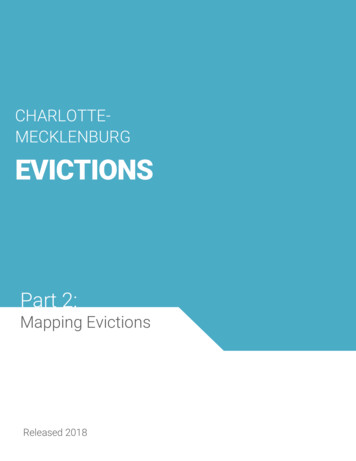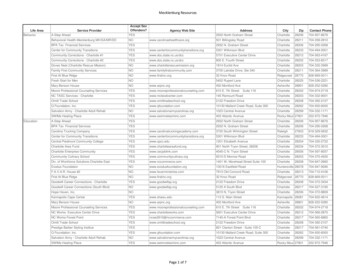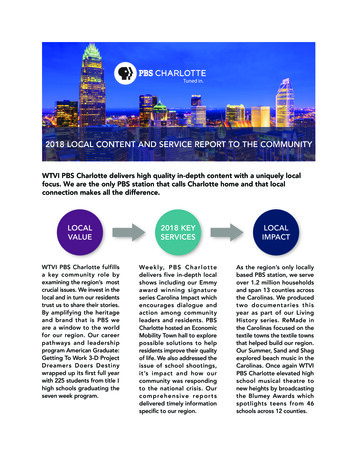
Transcription
CHARLOTTEMECKLENBURGSTRATEGIES FORAFFORDABLE HOUSINGDEVELOPMENTSeptember 2016
PREPARED BY:University ofNorth Carolinaat CharlotteUrban InstitutePREPARED FOR:The Housing Advisory Board ofCharlotte-MecklenburgFUNDING PROVIDED BY:Mecklenburg County CommunitySupport ServicesThe Housing Advisory Board of Charlotte-Mecklenburg (HAB), formerly known as the Charlotte-Mecklenburg Coalition for Housing,is a community based board appointed to implement the Charlotte-Mecklenburg Ten Year Plan to End and Prevent Homelessness.Members are appointed by the Mayor, City Council and the Mecklenburg County Board of Commissioners. HAB works with serviceproviders and community stakeholders to determine comprehensive, data-driven strategies to prevent and end homelessness andexpand the supply of safe, quality affordable housing. HAB looks to national best practices and local research to make itsrecommendations to community stakeholders and providers and advocates and advises on a strategic level to reduce homelessnessand increase affordable housing. In addition, HAB is responsible for the governance of the Continuum of Care in CharlotteMecklenburg, which carries out all activities as specified in 24 CFR part 578.5(b) of the Federal Register of the U.S. Department ofHousing and Urban Development.The UNC Charlotte Urban Institute is a nonpartisan, applied research and community outreach center at UNC Charlotte. Foundedin 1969, it provides services including technical assistance and training in operations and data management; public opinion surveys;and research and analysis around economic, environmental, and social issues affecting the Charlotte region.Graphic design: Ashley Williams Clark House Icon: "Creative Commons House Icon" by Paomedia, used under CC BY / Recoloredyellow from original. Cog Icon: "Creative Commons Cog Icon" by David Cross, used under CC BY / Recolored yellow from original.Cover photos from left to right: Nia Point, courtesy of Charlotte Housing Authority; Brightwalk, courtesy of Charlotte MecklenburgHousing Partnership; Park Terrace, courtesy of Laurel Street Residential.2 Authors & Reviewers
TERMAFFORDABILITYCONCLUSION4 AUTHORS & REVIEWERS5 ACKNOWLEDGEMENTS6 ABOUT7 KEY DEFINITIONS8 EXECUTIVE SUMMARY14 INTRODUCTION15 DEFINING AFFORDABLE HOUSING16 LOCAL CONTEXT19 CURRENT FUNDING SOURCES20 CHALLENGES23 EXPEDITED AND PREDICTABLE PROCESSES & FEEWAIVERS26 HOUSING IMPACT FEES29 HOUSING TRUST FUNDS32 LAND USE INCENTIVE POLICIES34 STRATEGIC USE OF PUBLIC, PRIVATE AND NONPROFIT OWNED LAND37 TAX INCREMENT FINANCING AND SYNTHETICTIFS41 INCREASED USE OF 4% LOW-INCOME HOUSINGTAX CREDIT43 AFFORDABLE HOUSING OVERLAY ZONES47 COMMUNITY LAND TRUSTS50 AFFORDABLE HOUSING DEED RESTRICTIONS52 EMPLOYER ASSISTED HOUSING55 INCLUSIONARY ZONING60 RECOMMENDATIONS61 REFERENCES
Authors & ReviewersAUTHORAshley Williams Clark, MCRPAssistant DirectorInstitute for Social CapitalUNC Charlotte Urban InstituteWITH ASSISTANCE FROMAngelique Marcus, MURPThomas Swiderski, MSWSocial Research SpecialistUNC Charlotte Urban InstituteSocial Research SpecialistUNC Charlotte Urban InstituteREVIEWERSZelleka Biermann, City of Charlotte Neighborhood &Business ServicesFulton Meachem, Jr., Charlotte Housing Authority,Housing Advisory BoardMary Gaertner, City of Charlotte Neighborhood &Business ServicesCourtney Morton, Mecklenburg County CommunitySupport ServicesHelen Lipman, Mecklenburg County CommunitySupport ServicesAmy Hawn Nelson, UNC Charlotte Urban Institute,Housing Advisory BoardBrandon Lofton, Robinson, Bradshaw and Hinson, P.A.,Housing Advisory BoardJoe Penner, Medic, Housing Advisory BoardStacy Lowry, Mecklenburg County Community SupportServices, Housing Advisory BoardMelanie Sizemore, Housing Advisory BoardPamela Wideman, City of Charlotte Neighborhood &Business Services, Housing Advisory BoardADDITIONAL INPUT PROVIDED BYHousing Advisory Board of Charlotte-MecklenburgResearch & Evaluation CommitteeCommunity Engagement and Advocacy Committee4 Authors & Reviewers
AcknowledgementsFUNDING PROVIDED BY:Mecklenburg County Community Support ServicesMANY THANKS FOR THE SUPPORT OF:Charlotte City CouncilCity of Charlotte Neighborhood & Business ServicesHomeless Services NetworkHousing Advisory Board of Charlotte-MecklenburgMecklenburg Board of County CommissionersMecklenburg County Community Support ServicesParticipants who were interviewedAcknowledgements 5
AboutThe 2016 Housing Instability & Homelessness Report Series is a collection of local reports designed to better equipour community to make data-informed decisions around housing instability and homelessness. Utilizing local dataand research, these reports are designed to provide informative and actionable research to providers, funders, publicofficials and the media as well as the general population.In 2014, the Housing Advisory Board of Charlotte-Mecklenburg outlined four key reporting areas that, together,comprised an annual series of reports for community stakeholders. The four areas include:1. Point-in-Time CountAn annual snapshot of the population experiencing homelessness in Mecklenburg County. This local reportis similar to the national report on Point-in-Time Count numbers, and provides descriptive information aboutboth the sheltered and unsheltered population experiencing homelessness on one night in January.2. Cumulative CountAn annual count of the population experiencing sheltered homelessness over twelve months. Like the Pointin-Time Count Report, this local report is similar to the national report on annual counts of shelteredhomelessness, providing descriptive information about the population experiencing shelteredhomelessness throughout the year. The Point-in-Time Count and Cumulative Count Reports arecomplements, and together help paint a picture of homelessness and trends in our community.3. Housing InstabilityAn annual report focusing on the characteristics and impact of housing instability in the community. Duringthe 2016 reporting cycle, this report will feature innovative affordable housing development strategies thatother communities have implemented.4. SpotlightAn annual focus on a trend or specific population within housing instability and homelessness. During the2016 reporting cycle, this report will focus on households with adults and children experiencinghomelessness within Mecklenburg County.The 2016 reporting cycle is completed by the UNC Charlotte Urban Institute. Mecklenburg County Community SupportServices provided funding for the report series. The reports can be viewed 6-Reports.aspx6 About
Key DefinitionsThese definitions are based on guidelines from the U.S. Department of Housing and Urban Development (HUD).Affordable HousingA household does not spend more than 30% of their pretax gross annual income on rent and utilities.Extremely Low-IncomeHUD Area Median Family elopment estimates the median family income foran area in the current year and adjusts that amount forA household’s annual income is less than 30% of the areadifferent family sizes so that family incomes may bemedian income.expressed as a percentage of the area median income.Fair Market Rent (FMR)According to 24 CFR 5.100, Fair Market Rent (FMR) meansHAMFI is frequently referred to as median family income(MFI), or area median income (AMI). For more details, see“Explaining AMI” on page 9.the rent that would be required to be paid in theparticular housing market area in order to obtainLow-Incomeprivately owned, decent, safe and sanitary rental housingA household’s annual income is between 51% and 80%of modest (non-luxury) nature with suitable amenities.of the area median income.The FMR includes utilities (except telephone). SeparateFMRs are established by the U.S. Department of Housingand Urban Development for dwelling units of varyingsizes (number of bedrooms).Homeownership RateThe number of owner-occupied units as a percentage ofall occupied housing units.Housing Choice VoucherThe federal government’s major rental assistanceprogram for assisting very low-income households, theelderly, and those with disabling conditions to afforddecent, safe, and sanitary housing in the private market.Housing Cost BurdenedIf a household spends more than 30% of their pre-taxgross annual income on rent and utilities, then they areconsidered housing cost burdened. If a householdspends more than 50% of their gross income on rent andutilities, then they are considered extremely housing costMixed-Income HousingHousing development that includes a diversity of units ata variety of price points.Moderate-IncomeA household’s annual income is between 81% and 120%of the area median income.Workforce HousingHousing that is affordable to households earning 60% to120% of AMI.TenureRefers to whether a unit is owner-occupied or renteroccupied.Very Low-IncomeA household’s annual income is between 30% and 50%of the area median income.burdened.Key Definitions 7
Executive SummaryThis section provides an overview of the challenges to affordablehousing development in Charlotte-Mecklenburg and a summary ofstrategies used in communities across the country to finance andfacilitate affordable housing ces areincreasingWages arenot keepingpace8 Executive SummaryPopulationis increasingMajority oflow-incomerenters arecost burdenedDisparities ofopportunity alongrace and economiclines exist
CHALLENGES INCHARLOTTE-MECKLENBURG FINANCIAL FEASIBILITY Land acquisition costs Land availability and zoning Length and unpredictability ofpermitting process Lack of financing Increasing development costs Neighborhood oppositionLONG-TERM AFFORDABILITY Affordability periods expiring oncertain subsidized units Need for long-term affordabilityRECOMMENDATIONS4Examine local policies and ways inwhich they might contribute to barriersto affordable housing development.Engage a variety ofstakeholders.5Make the business and economic casefor affordable housing.Develop a database of publicand privately owned land.6Keep long-term affordability in mind.1Start now.23Executive Summary 9
SUMMARY OF riptionEntity &PartnershipsFINANCINGEXPEDITED ANDPREDICTABLEPROCESSES & FEEWAIVERSProvide expedited buildingpermitting processes that arepredictable and reduced feesto help decrease thedevelopment costs ofaffordable housing.Charlotte-Mecklenburg currentlydoes not have an expedited processfor affordable housing developers. Atone point, the City of Charlotte hadexpedited permitting processes thatwere available to all developers, butdue to the influx in building permitrequests, the expedited option hasbeen discontinued. There is concernthat some aspects of the permittingprocess are difficult to predict andadd to development costs.HOUSING IMPACTFEESA fee on non-residentialdevelopment that is used tooffset the increased need foraffordable housing becauseof development.Based on previous legislation in NorthCarolina on the use of impact fees, itis unlikely that housing impact feeswould be permissible, however, theyare still an important tool tounderstand.Dedicated source of publicfunding for affordablehousing.Charlotte‘s Housing Trust Fund (HTF)was established in 2001 and providesgap financing to affordable housingdevelopers for acquisition, newconstruction, and rehabilitation ofmultifamily affordable units.Charlotte’s HTF is frequently turnedto as a best practice. Oneconsideration however, is that theHTF is based on bonds that must beapproved every several years ratherthan a dedicated on-going fundingsource or a diverse portfolio offunding sources that can be utilizedas needed.HOUSING TRUSTFUNDS10 Executive SummaryCITYCOUNTYCITYCOUNTYSTATECITY
LAND USEINCENTIVE POLICIESReduction in fees and grantsbacked by property taxes inexchange for inclusion ofaffordable and “locationallyefficient” units.This strategy has not beenimplemented in CharlotteMecklenburg, but is feasible withinNorth Carolina. The tool couldpotentially be combined with abroader strategy to expediteprocesses and fees; however, it isimportant to ensure that there is alarge enough incentive for developersto participate in the program.STRATEGIC USE OFPUBLIC, PRIVATE,AND NON-PROFITOWNED LANDLands are donated or sold ata reduced price for thedevelopment of affordablehousing as a standaloneproject or in conjunction withdevelopment of publicfacilities.The City of Charlotte approved theselling of public lands in the Cherryneighborhood at a reduced cost.Cherry is a historically AfricanAmerican community experiencingchanges in demographics andhousing prices. A database of all landowned by public institutions, faithbased organizations, and non-profitsthat have the potential for affordablehousing development could behelpful in exploring use of thisstrategy.TAX INCREMENTFINANCING ANDSYNTHETIC TIFsTIFs and Synthetic TIFs workby incentivizing and payingfor the construction of newbuildings and publicresources that will improveproperty values and taxrevenues in the specifiedarea, then using thoseincreased revenues to pay forthe project.TIFs are a tool currently available toCharlotte-Mecklenburg but this toolhas not been used widely. The mostrecent, was a synthetic TIF (differentfrom a regular TIF) used for thedevelopment of Brightwalk, a mixedincome community developed by theCharlotte-Mecklenburg HousingPartnership.INCREASED USE OF4% LOW-INCOMEHOUSING TAXCREDIT (LIHTC)The 4% LIHTC is anunderutilized automatic taxcredit for projects financed atleast 50% with tax exemptbonds. Use of the programoften requires exploringadditional sources of equity,from programs like a HousingTrust Fund, to make projectsfinancially feasible.The 4% tax credit is a tool that iscurrently available for use inCharlotte-Mecklenburg and has beenused by a small number ofdevelopers. Examples of 4%developments in CharlotteMecklenburg include Strawn Towerand Parktowne Terrace, which weredeveloped by the Charlotte HousingAuthority, and the Allen StreetResidential, which was developed byLaurel Street Residential.CITYCOUNTYCITYCOUNTYCHARLOTTE MECK.SCHOOLSPHILANTHROPICCOMMUNITYFAITH COMMUNITYNON-PROFITCOMMUNITYPRIVATE PROPERTYOWNERSCITYCOUNTYCITYExecutive Summary 11
AFFORDABLEHOUSING OVERLAYZONEA flexible zoning technique inwhich a new zoning districtwith modified standards isdrawn on top of a basezoning district.Currently, there are no affordablehousing overlay zones in ONG-TERM AFFORDABILITYCOMMUNITY LANDTRUSTSThe trust permanentlyretains the land while thehomebuyer owns the homethat is located on this land.Affordability requirementsand resale restrictions aretied to sale of the property,ensuring long-termaffordability.Charlotte-Mecklenburg does notcurrently have a community landtrust.AFFORDABLEHOUSING DEEDRESTRICTIONSAffordable housing deedrestrictions can control theresale price of a homethrough a formula thatdetermines the affordableresale price of the home,protecting long-termaffordability.Deed restrictions are currently anavailable tool in CharlotteMecklenburg.EMPLOYER ASSISTEDHOUSINGGenerally, employer assistedhousing refers to a housingprogram that is fully orpartially financed by anemployer to incentivize andbenefit employees tobecome homeowners orhave access to affordablehousing. On the developmentside, employers can providecash financing fordevelopment costs, donateland, or develop affordablehousing themselves.Engaging employers in CharlotteMecklenburg’s affordable housingstrategy could be mutually beneficialfor employers, workers, and theCharlotte community as a whole.INCLUSIONARYZONINGInclusionary zoning policiestry to increase affordablehousing by linking affordablehousing to market-rateprivate development througheither voluntary incentivebased or mandatoryrequirements to include acertain percentage ofaffordable housing units inmarket rate developments.Created in 2013, Charlotte has avoluntary, incentive-based densitybonus program. However, to date,the program has not been used andconcern was voiced by intervieweesthat it does not provide an adequateincentive to developers in the currenthousing market.12 Executive SummaryCITYCOUNTYCHARLOTTE MECK.SCHOOLSPRIVATE PROPERTYOWNERSCITYBUSINESSCOMMUNITYSTATECITY
CASE STUDY OVERVIEWStrategyCase Study:LocationNumber of Affordable Units orRevenue GeneratedDates of UnitCreationFINANCINGEXPEDITED ANDPREDICTABLE PROCESSES &FEE WAIVERSPinellas County, FLHOUSING IMPACT FEESArlington County, VAAnticipated 14M in revenue2013 to 2016HOUSING TRUST FUNDSCharlotte, NCOver 5,700 units2001 to 2016Seattle, WAOver 12,500 units1981 to 2016Arlington, VAApproximately 7,000 units1988 to 2014LAND USE INCENTIVEPOLICIESAsheville, NC72 units2010 to 2016STRATEGIC USE OF PUBLIC,PRIVATELY, AND NONPROFIT OWNED LANDSWashington, DCRegionArlington Mills - 122 units2014Bonifant at Silver Spring - 139 units2015115 H Street - 4 units20151,067 unitsFY 2012 to 2013TAX INCREMENTFINANCING4% LOW-INCOME HOUSINGTAX CREDITAFFORDABLE HOUSINGOVERLAY ZONESSan Diego, CAN/AAsheville, NCPortland, ORN/AArlington, VA30 units built on-site2005 to 20140 units built off-site 36.2M in contributions to Affordable HousingInvestment Fund, which was used to finance426 affordable units.Menlo Park, CAN/ALONG-TERM AFFORDABILITYCOMMUNITY LAND TRUSTSOrange County, NCApproximately 240 homes2000 to 2016Denver, CO254 rental homes2005 to 2013Current land holdings will also enable thefuture development of at least 750 additionalaffordable apartments.DEED RESTRICTIONSEMPLOYER ASSISTEDHOUSINGRochester, MN784 units (671 rental units and 113 singlefamily homes)1996 to 2013INCLUSIONARY ZONINGAustin, TX15,351 units2000 to 2014N/AExecutive Summary 13
IntroductionThis report presents several strategies that can be used to finance and facilitate thedevelopment of quality affordable housing, with a focus on long-term affordability.A community’s adequate supply of affordable housing plays an important role in creating inclusivecommunities, attracting and retaining a workforce, improving the well-being of households and creatingeconomic opportunity.The focus and context of this report was informed by interviews conducted with local and state policy makers,for-profit developers, non-profit developers, advocates, and thought leaders. Through these interviews, twomain themes emerged that highlight the challenges in developing affordable housing in CharlotteMecklenburg—challenges to financial feasibility including the cost of neighborhood resistance, andchallenges to developing long-term affordability of housing. These challenges are not unique to Charlotte;they are faced by communities nationwide.This report will focus on strategies for financing affordable housing development and ensuring long-termaffordability of affordable housing units. Strategies were identified by examining national reports andliterature to highlight best practices and innovative strategies for developing affordable housing. Eachstrategy is presented with a high-level overview followed by a case study describing what the strategy lookslike in practice. This report does not make a determination on which strategies are best or most feasible forCharlotte-Mecklenburg as any approach will need to be multifaceted and unique to the needs and contextof the community.While this report focuses on the development and production of affordable housing, there are many otheraspects of affordable housing that need to be approached simultaneously. These aspects include affordablehousing preservation and rehabilitation (both subsidized1 and naturally occurring), asset building,2supportive services, property management, vouchers, diversity of housing options, responsibleredevelopment, strengthening of existing communities and access to credit for homeowners. Anotherimportant aspect of affordable housing is examining who is served by affordable housing and where thathousing is located. This report acknowledges that the community will not be able to build its way out of itsaffordability crisis and there will continue to be a shortage of affordable housing if wages do not keep pacewith housing costs.While we recognize that not all strategies are immediate options in Charlotte-Mecklenburg, there is still abenefit from raising awareness of each strategy and placing them into consideration as future tools.Additionally, different strategies may be more or less applicable depending on the local housing marketdynamics of each neighborhood. Underlying all of these strategies is the goal that affordable housingdevelopments provide safe, sound, habitable housing with features that are undistinguishable from otherhousing.The strategies presented in this report are not meant to be used in isolation, but used in combination withother strategies and the continued strengthening of partnerships between the public sector, private sector,faith, and philanthropic communities.The goal for this report is to serve as a starting point for further discussion and examination into how thesestrategies could be applied within Charlotte-Mecklenburg.14 Introduction
Defining AffordableHousingDefinitions of housing affordability may vary dependingon the program, however, in general terms, housing isconsidered affordable if a household does not have topay 30% or more of their pre-tax gross income onhousehold expenses.One way of targeting resources is by using HUD Area MedianFamily Income (HAMFI or MFI) limits to set income eligibility levelsfor housing programs. HAMFI limits are based on the areamedian income (AMI), which is typically developed using U.S.Census data. HUD calculates these limits based on census dataand makes adjustments based on family size and housingmarket. In addition to their use in determining HUD programeligibility, these income categories, shown in Figure 1, arefrequently referenced when discussing affordable housing morebroadly. Note, that some income limits may vary by program.The Housing Advisory Board of Charlotte-Mecklenburg hasdecided to focus their affordable housing efforts on householdsat 0 to 80% of AMI. 29,290 34,560A preschool teacher makingmedian wage ( 29,290)with two children wouldqualify as very low-income.In 2016, in order to afford a2-bedroom housing unit inMecklenburg County at fairmarket rent, a householdwould need to earn 34,560.Figure 1. FY 2015 HAMFI LimitsEXTREMELYLOW-INCOME 30% MFIVERYLOW-INCOME31-50% MFILOWINCOME51-80% MFIMODERATEINCOMENOTLOW-INCOME81-120% MFI 120% MFITable 1. FY 2016 Charlotte-Mecklenburg Income Limits Summary1Person2Person3PersonExtremely Low (30%) 14,10016,10020,160Very Low (50%) 23,45026,800Low (80%) 300 ning Affordable Housing 15
Local ContextSeveral factors provide context to the affordable housing discussion in Charlotte-Mecklenburg.These factors are summarized below and are important to take into consideration as the discussionaround affordable housing continues. 3 4HOUSING PRICESWAGESHousing prices are increasingWages are not keeping pace with housingIn October 2015, housing prices in Charlotte surpassedtheir pre-economic recession peak, as measured by theCase-Shiller Home Price index. The index, which measuressingle-family home repeat sales, continued to increasethrough May 2016. Rental costs increased as well. Basedon data from the American Community survey, from 2008to 2014 the median gross rent increased by 7%.Based on American Community Survey data, from 2005 to2014, the median household income in MecklenburgCounty decreased 3%, while the median gross rentincreased 7%. A worker earning the federal minimumwage of 7.25 per hour must work approximately 92 hoursa week to afford a basic two-bedroom apartment at fairmarket rent.POPULATIONCOST BURDENPopulation is increasingMajority of low-income renters are cost burdenedFrom 2010 to 2015, Mecklenburg County grew by 114,000people or 12.4%. It is estimated that even under the mostconservative of scenarios (high mortality rates, low birthrates, and low mobility), the Charlotte commuting zone willgrow by at least 21% between 2010 and 2030. When usingmoderate estimates, the Charlotte commuting zone isestimated to grow as much as 47%.3 At the same time, thenumber and proportion of renters is increasing and it isanticipated that by 2030 there will be more renters thanhomeowners.From 2010 to 2014, 46% of renter-occupied householdsand 27% of owner-occupied households spent more than30% of their gross income on housing. For renteroccupied households, 90% of extremely low-incomehouseholds (0 to 30% HAMFI) and 84% of low-incomehouseholds (31 to 50% HAMFI) were cost burdened from2008 to 2012.416 Local Context
GEOGRAPHY OFOPPORTUNITYDisparities of opportunity along race andeconomic lines existThe development of housing in CharlotteMecklenburg and the geographic patterns ofopportunity seen today are reflective of a legacy ofpolicies and actions that either intentionally orunintentionally have had discriminatory effects. Pastand current policies and practices, such as tration (FHA) backed mortgages, redlining,the exclusion of African American veterans from theGI bill, urban renewal, reverse red-lining, predatorylending to communities of color, lack of access tocredit, and discrimination based on source ofincome, disproportionately impact households ofcolor and households living in poverty. Thesediscriminatory effects inhibit opportunities forCharlotte-Mecklenburg’s community members, andmust be acknowledged in order to be addressed.Affordable housing policy and practices have thepotential to address or perpetuate ssing affordable housing location as it relatesto segregation and access to opportunity isespecially pertinent given the 2015 U.S. SupremeCourt case Texas Department of Housing andCommunity Affairs v. The Inclusive Communities Project.In this case, the Supreme Court affirmed that FairHousing Act violations are not limited to intentionalviolations but also if “disparate impact” on protectedclasses can be proven.In response, the U.S. Department of Housing andUrban Development issued a final rule onAffirmatively Furthering Fair Housing, clarifying andstrengthening the responsibility of HUD programparticipants and the broader community to addresseconomic and racial segregation, fair housingchoice, and access to opportunity.To assistcommunities in completing a required Assessmentof Fair Housing to inform determining local fairhousing priorities and goals, HUD developed a fairhousing assessment tool. Additional information onthe final rule and tool are on HUD’s website:https://www.huduser.gov/portal/affht pt.html#affhOfficial Residential Securiy Map of Charlotte from 1935. Areaswere marked with a grade of 1 (green), 2 (blue), 3 (yellow) or 4(red). Areas marked 1 were considered more desirable andareas marked 4 were considered more hazardous. Thesedesignations are argued to have influenced where the FederalHousing Authority and private lenders restricted lending.Source: Mapping Inequality: Redlining in New Deal America. Retrievedfrom: http://dsl.richmond.edu/holc national/Last year’s report, Housing Instabilityin Charlotte-Mecklenburg, providesadditional details on the overall impactof housing instability and need foraffordable housing in CharlotteMecklenburg.See Local Context 17
These factors provide a high-level summary of the complex anddynamic environment in which discussions about the challenges ofaffordable housing development in Charlotte-Mecklenburg takeplace.“Once a housing marketaccelerates andgentrification occurs, itbecomes more expensiveto provide affordablehousing. It then takespolitical will to createincentives or regulationsto build affordablehousing, and theforesight to produce andretain affordable housingbefore the need becomespressing.”Charlotte-Mecklenburg is growing at a fast pace, and much of thisgrowth has been in the last few decades. In the case of CharlotteMecklenburg, population growth combined with the after effects ofa down market and a movement of people back to urban areas (atrend seen nationwide) are creating changes and pressures in thehousing market. This is especially true within the rental market.Charlotte-Mecklenburg is experiencing a rental development“boom.” However, much of the growth is in higher income marketsand is not experienced equally across neighborhoods.This growth makes the issue of affordable housing and ensuringhousing affordability across a variety of housing price pointsespecially pertinent. Compounding this is the fact that housing is acommodity that takes time to produce, so the population in thecommunity may grow at a faster rate than the amount of housing.In addition, land costs may rise quickly in communities that hadpreviously been more affordable.- Urban Institute, Strategies toDevelop Affordable HousingIncreased demand in certain neighborhoods has the potential toresult in the displacement of residents and increases in housingcosts and housing cost burdens.5 Additionally, high demand forrental housing can make it difficult for Housing Choice Voucher(formerly known as the Section 8 voucher) holders to find units because they are competing for units againsthouseholds that have higher incomes and less requirements. Discrimination based on income source (ex. denyingsomeone a unit because part of their rental payment would come from a Section 8 voucher) is not protected underfair housing law in North Carolina.Popula
The Housing Advisory Board of Charlotte-Mecklenburg (HAB), formerly known as the Charlotte-Mecklenburg Coalition for Housing, . The 2016 Housing Instability & Homelessness Report Series is a collection of local reports designed to better equip our community to make data-informed decisions around housing instability and homelessness. Utilizing .








![Mecklenburg College Annual Catalogue [1963-1964]](/img/32/mecklenburgcolle159carv.jpg)

